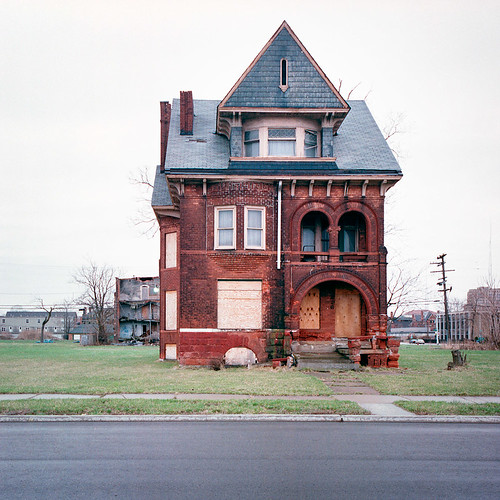
This one's a follow-up to the Detroit post, as I really wanted to touch on the aspect of urban decay and blight. Take a look at this photo from the amazing site Motorless City, which chronicles via photographs the physical decay of the city. How beautiful this house must have been back in the day, a stately mansion that probably had some rich family living it in, raising their children. Now, it is broken down version, surrounded by an open field and an another architectural skeleton. Perversely, I find the current image more appealing. In fact, I've always found these one of the most enticing aspects of urban space. I know, I know, what kind of an urbanist am I?
I don't have a great explanation, as my head knows that these foreboding conditions are what provide fodder for the haters and keep people from moving to them. But, having grown up in Philly in the 80s, it was a big part of my visual language. Burnt-out houses on Green Street and all over North Philly. Tags everywhere. Weeded lots. There was something beautiful in it, that ugliness held a power that a manicured lawn and flower bed never could. It has extended to my artistic aesthetics as well, fueling my love for film noir, Mean Streets, Hubert Selby Jr.'s books, Mobb Deep's The Infamous, graffiti, etc.
I've tried to think about why and think I've come up with some thoughts. For me, this ominous look provides the grit and ugliness that I associate with the urban; it's the complete opposite of the sanitized, "pretty" surburban look and in some ways I always define the urban as anti-suburban. In fact, I would suggest that our entire pop culture is obsessed with perfection, ashamed of anything that doesn't fit this norm. That attitude definitely explains why the cities are looked at with hostility in this country, as you can't hide from poverty, violence and blight within those limits. In the land of studio pop stars, Dr. 90210 and US Weekly, it's a radical choice to exalt decaying buildings.
Or perhaps it's that sense that in a city, nothing remains dead for long. There is always a chance for rebirth, there's always a chance to re-use or restore an old building, as evidenced by the many people living in former factory buildings. Even in a decrepit house like the above, there's still a hopefulness to me, a sense that someday that place could be restored to its former grandeur or it could become a boutique hotel or a community center or who knows what.
All of which leads to my greater point which is that there is a real urban aesthetic, a way of seeing the world differently. I hope to pursue this more and more as I write here, but this seemed like a good chance to establish these ideas. These buildings serve as a sort of shibboleth for me, a test of whether or not you really feel comfortable in this world, whether you can see the hope in a rundown house or the conversation behind the scrawlings on walls.

No comments:
Post a Comment